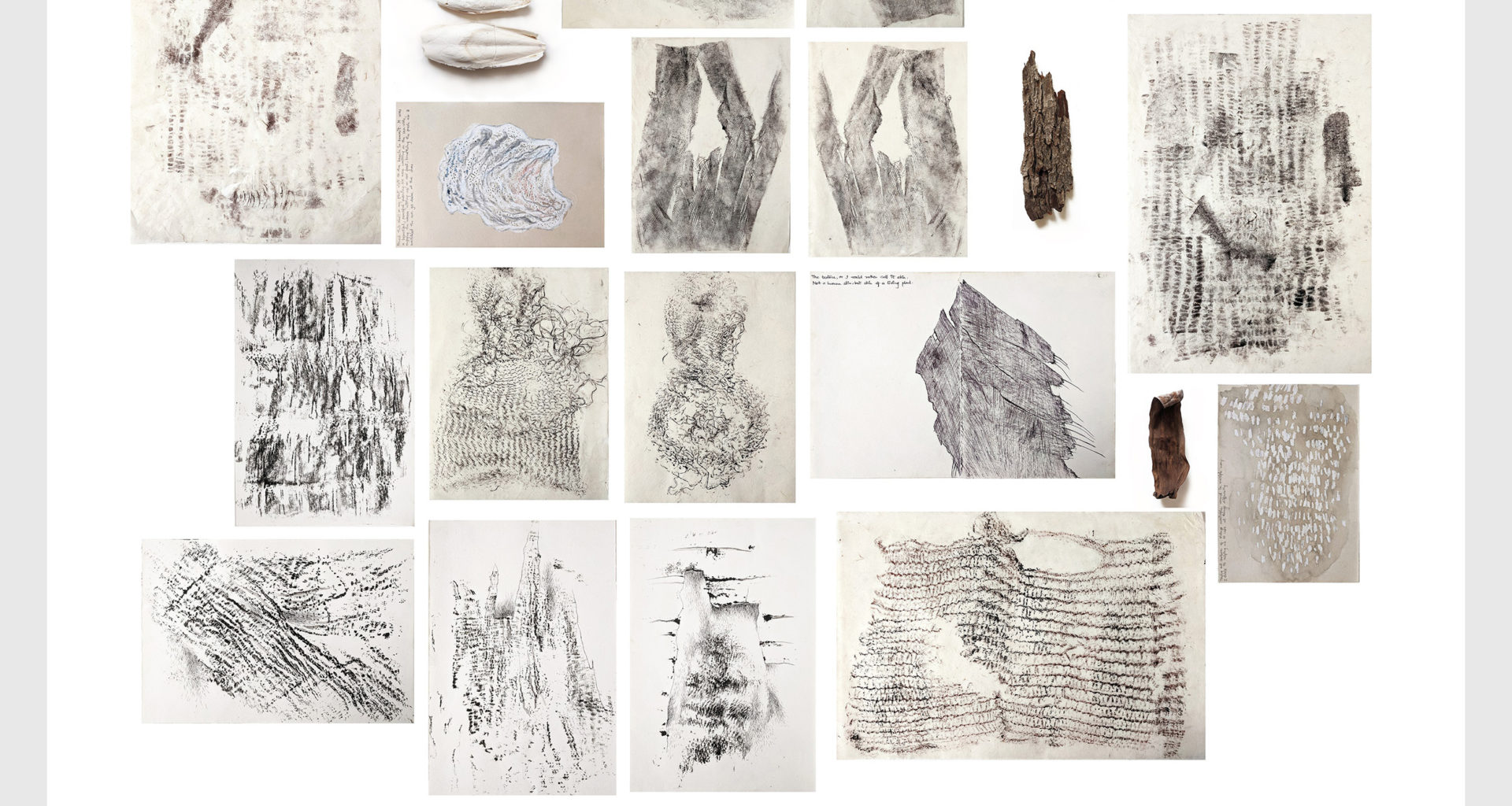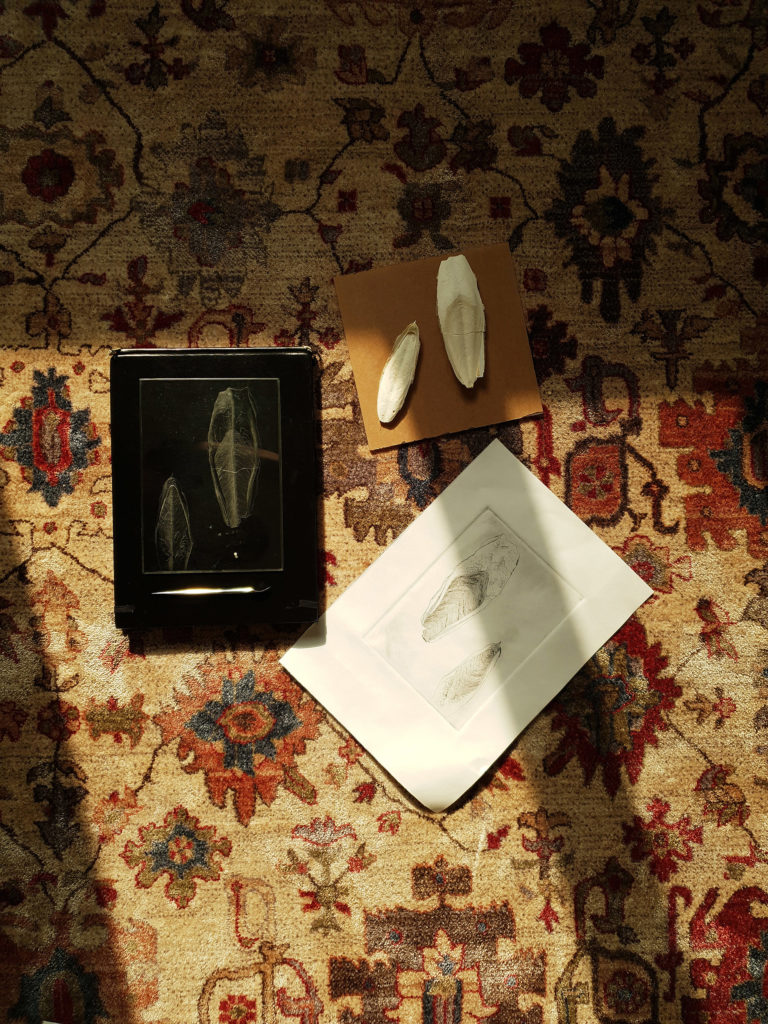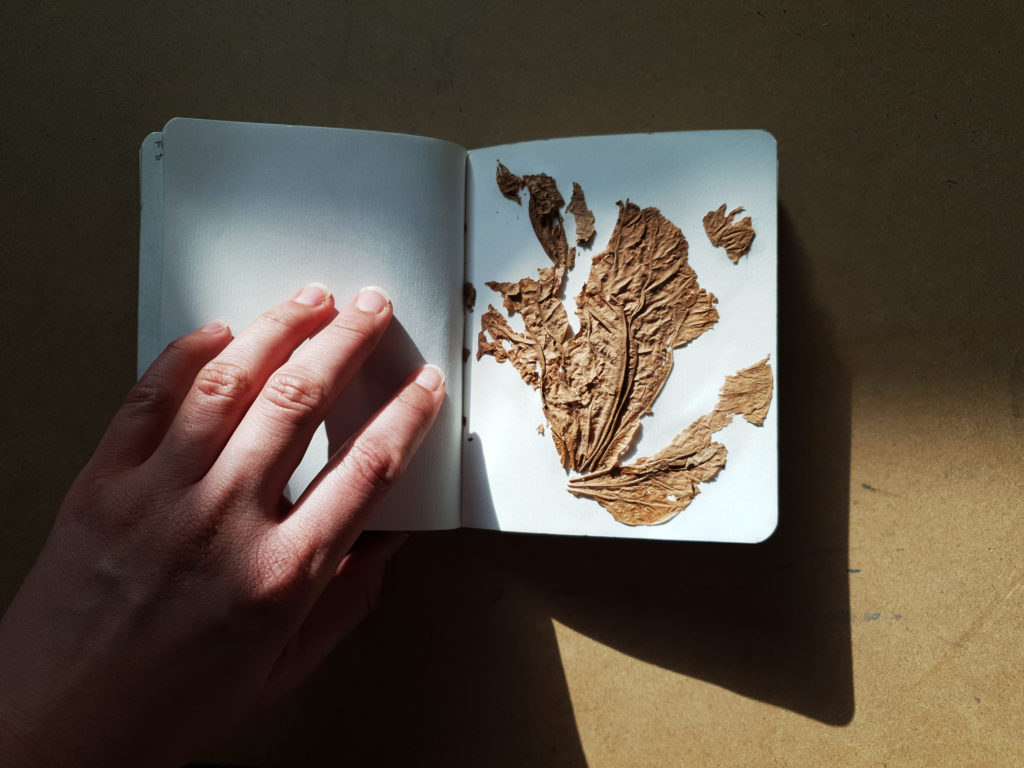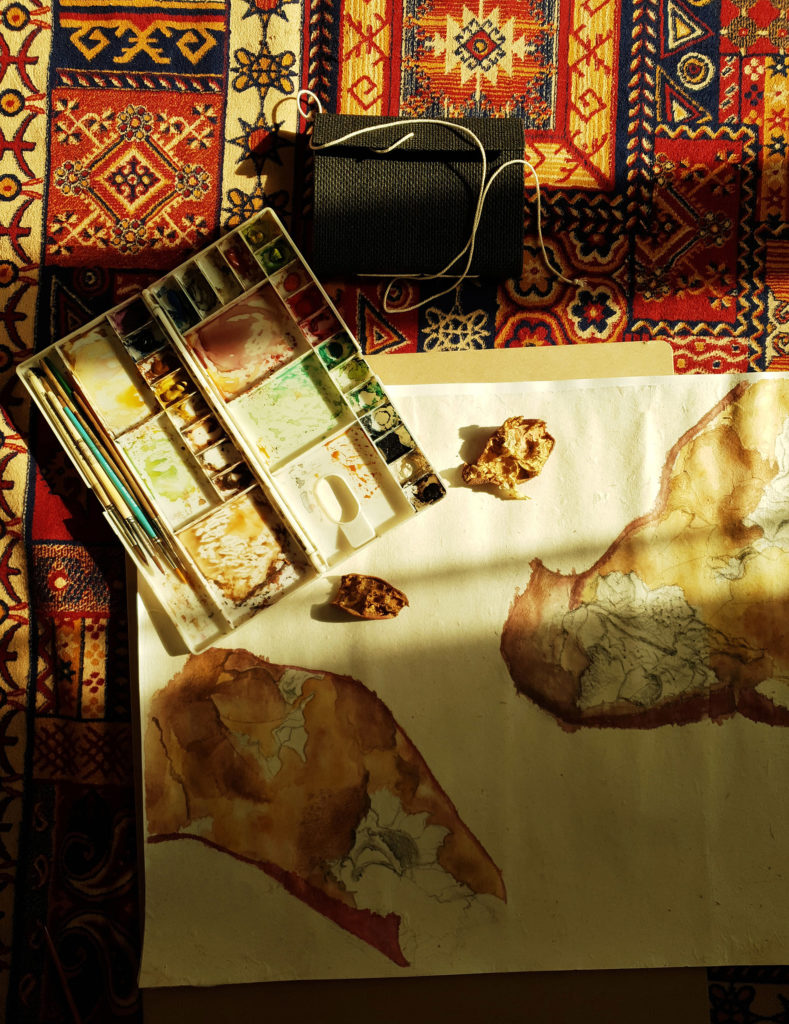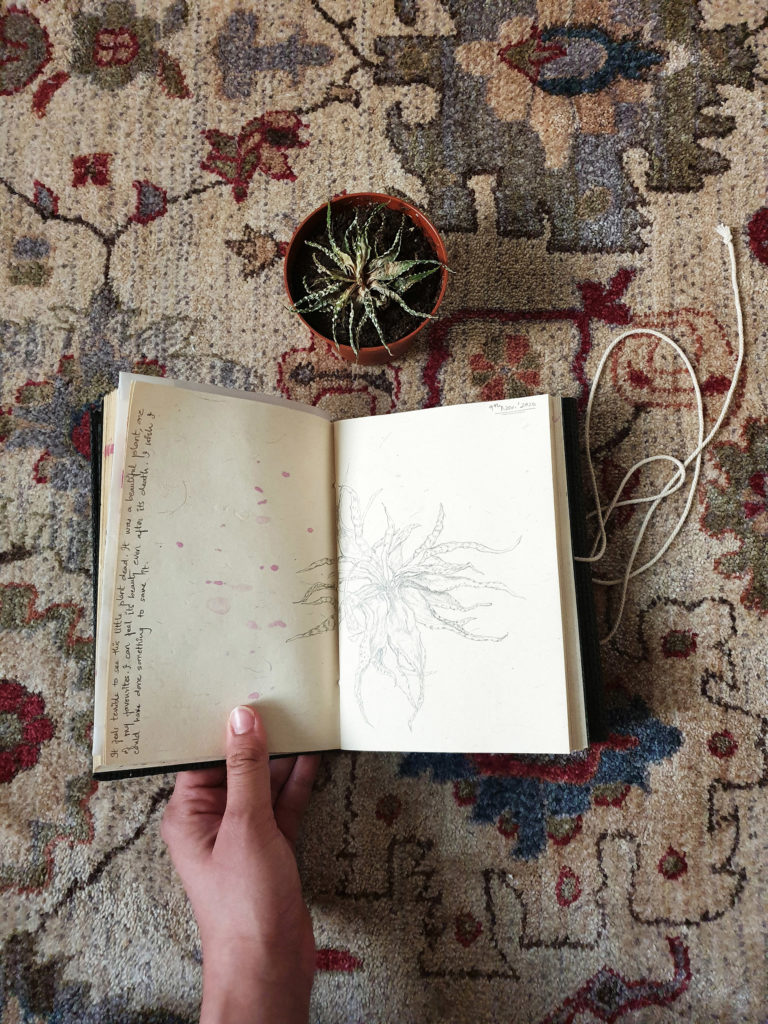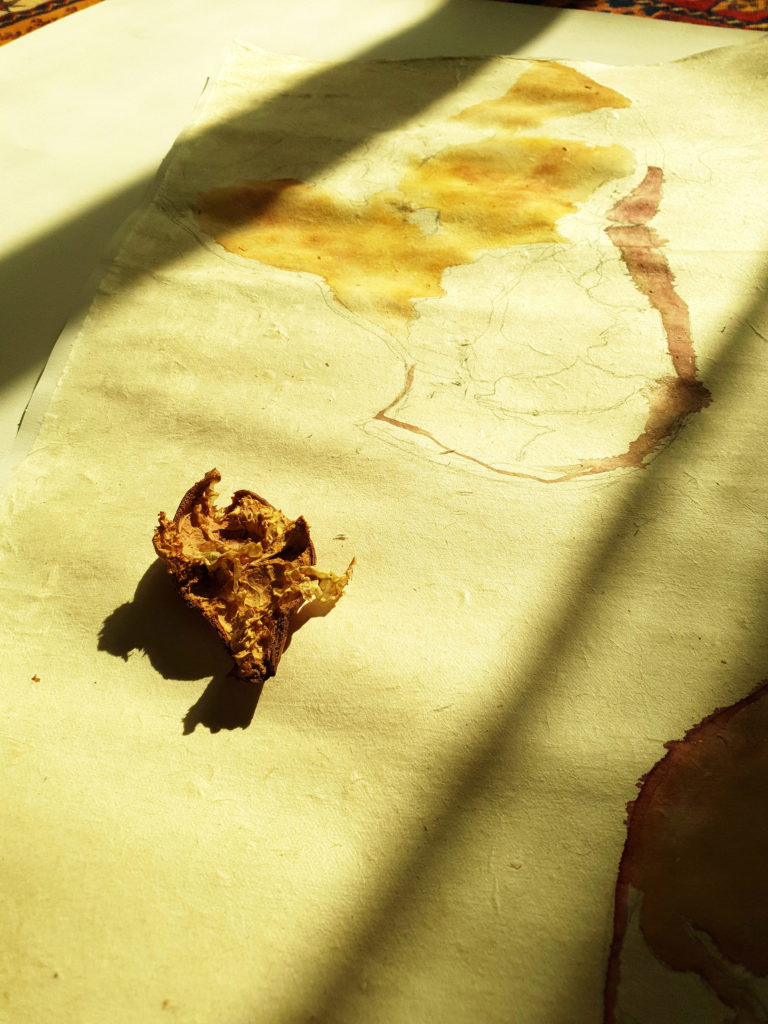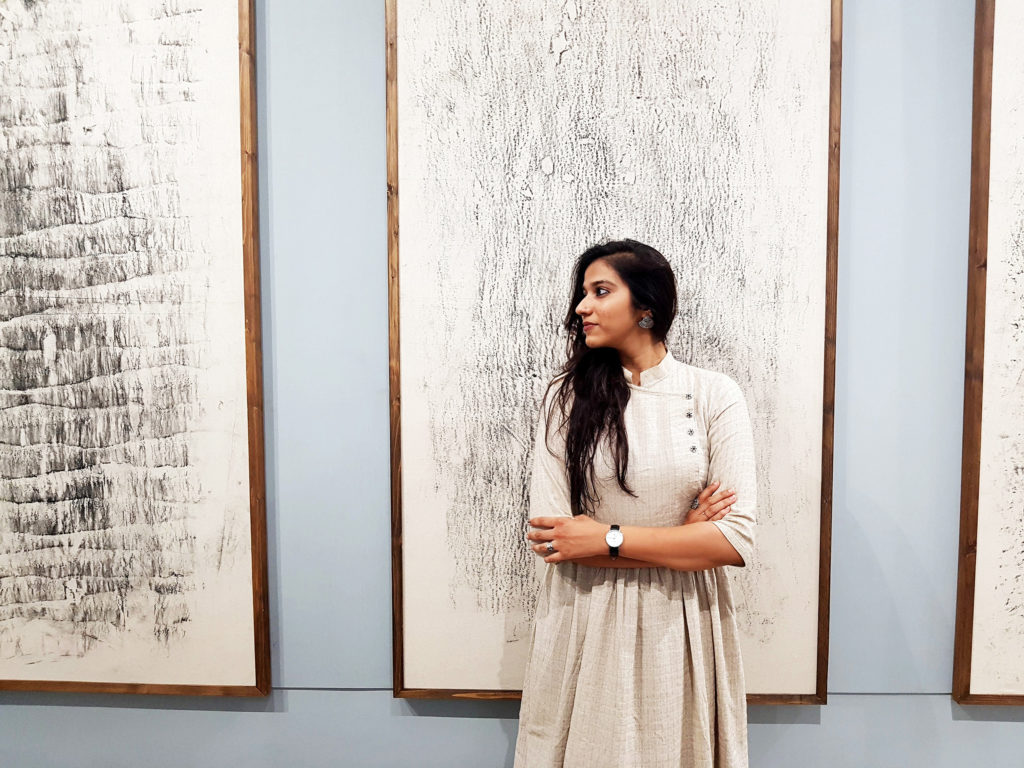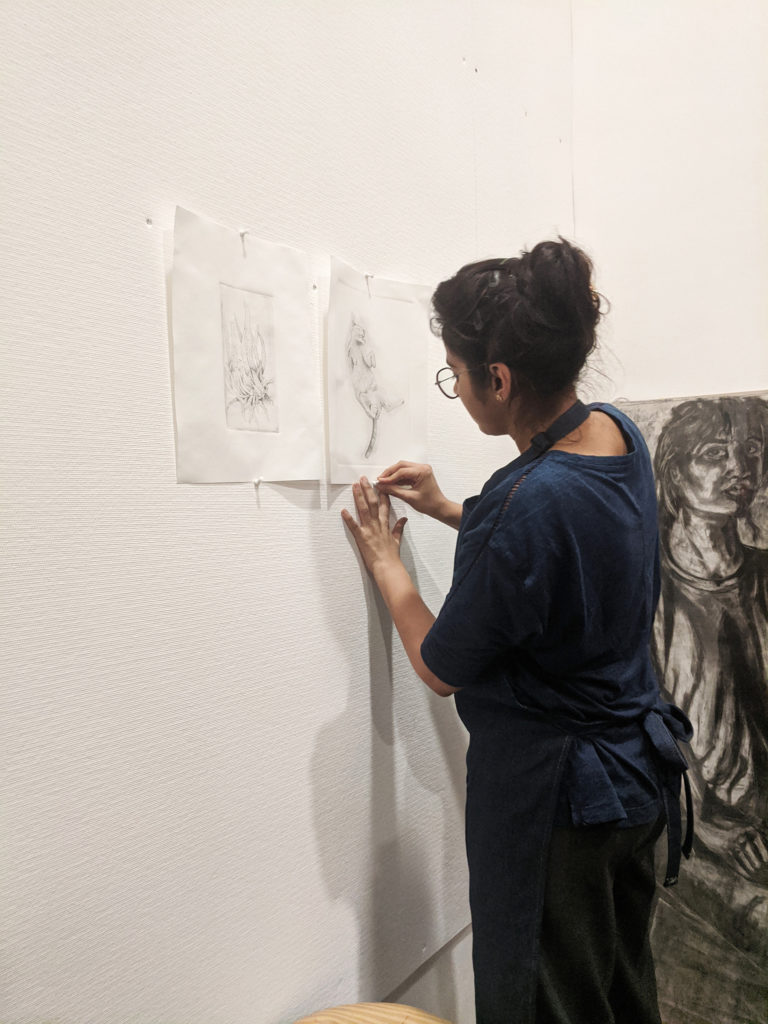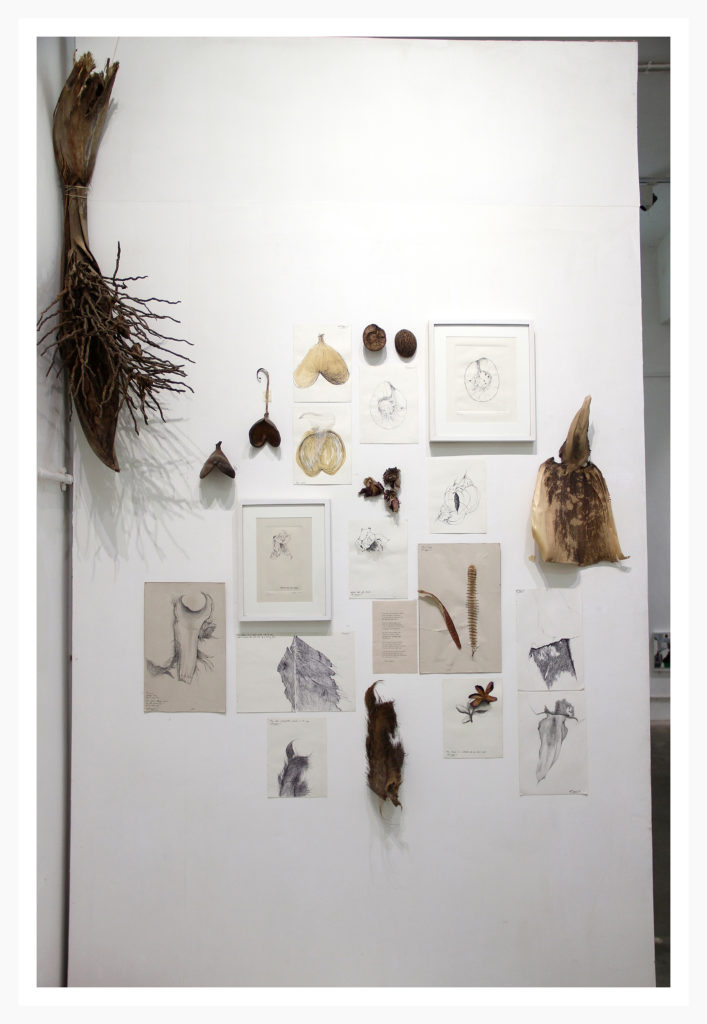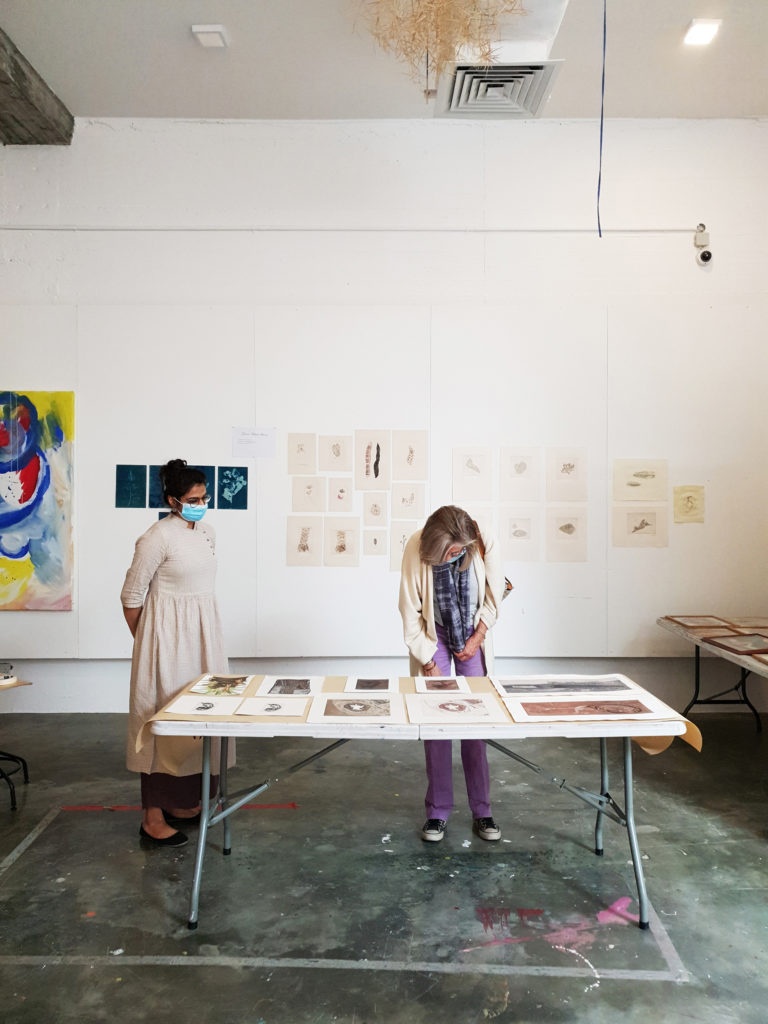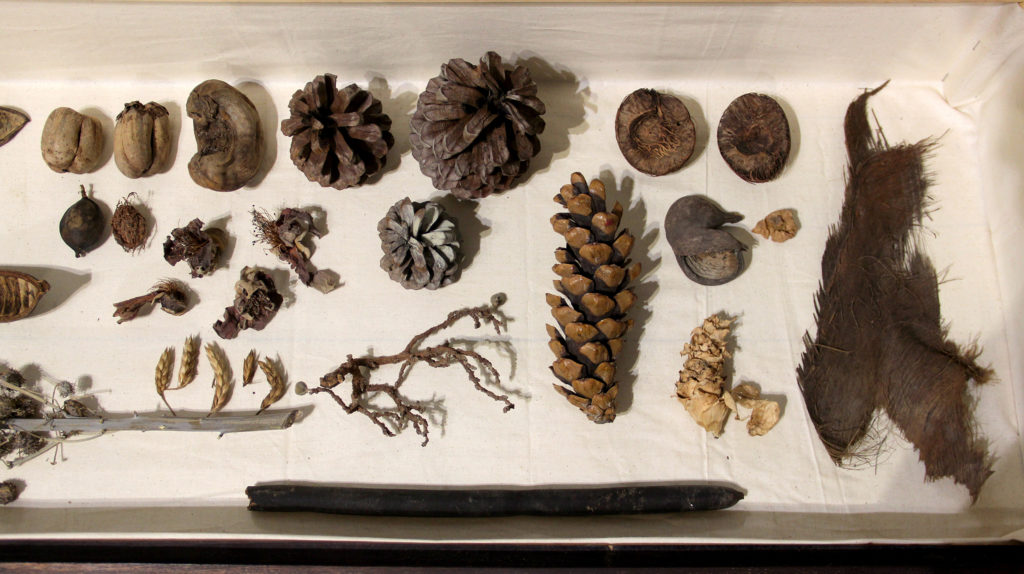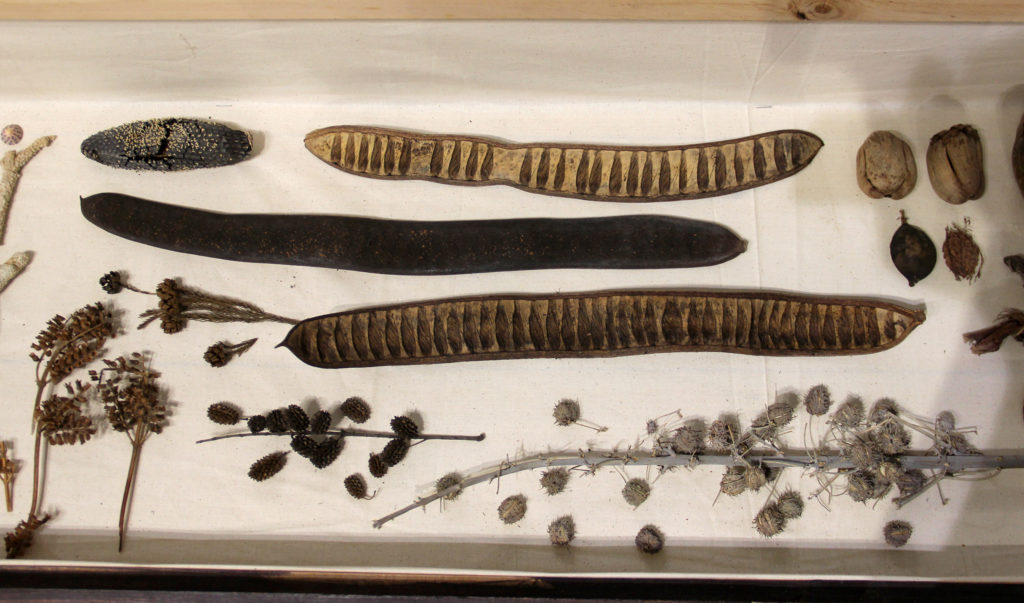Words: Zainab Mirza
Images: Zarrin-Fatima Shamsi
Zarrin-Fatima Shamsi is an emerging visual artist and printmaker who moved to Kuwait from India in 2019. What makes her prints unique is her inclination towards natural objects, like leaves and shells, and how she incorporates impressions of them into monoprints. As the pandemic moved life online, Shamsi displayed her art in numerous virtual exhibitions during the past year.
I met Zarrin virtually for a conversation about her printmaking journey, her techniques, and what her objects mean to her and her art.
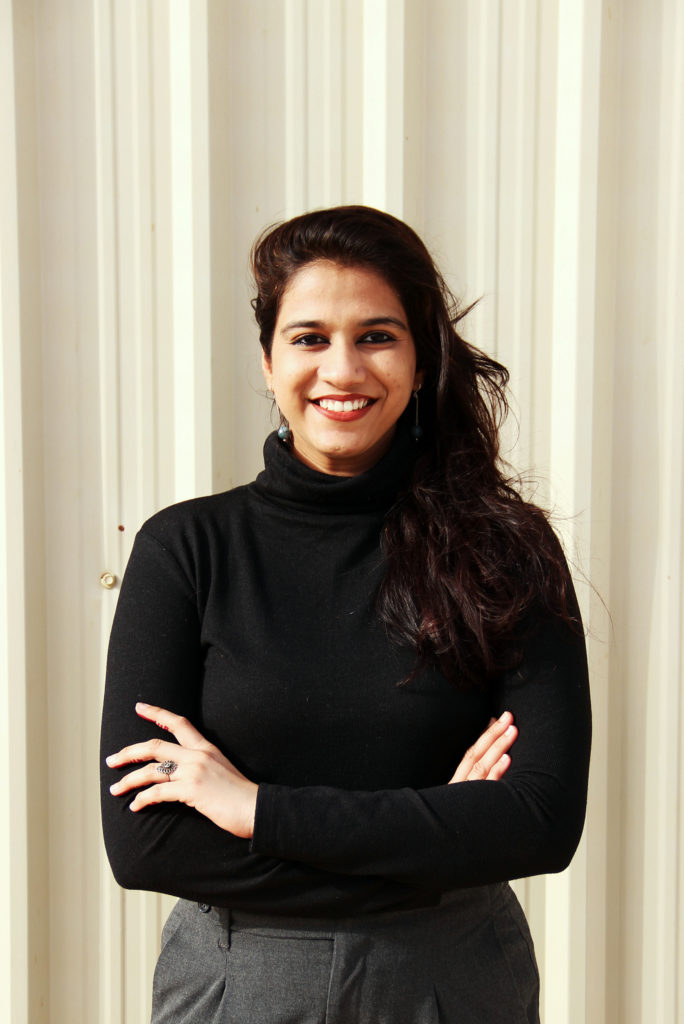
Zainab Mirza (ZM): What was your relationship with art like as a child and when were you first introduced to it?
Zarrin-Fatima Shamsi (ZFS): For me as a child, art was like a runaway. I used to hate studying other subjects, especially maths and science. As a kid, art was something I enjoyed doing and it satisfied me. So I always try to engage myself in more and more activities. I was introduced to art during my summer vacations when I used to join art classes for a month. That's where I learnt more art and craft related skills.
ZM: You got your master’s degree in visual arts in 2019. Could you tell us more about your background and artistic journey? Were there any key experiences that shaped you into the artist you are today?
ZFS: After finishing 12th grade, I applied for fine arts at MSU in Baroda, India [The Maharaja Sayajirao University of Baroda]. But I couldn’t get in at my first attempt. So I took a break for a year [gap year] and continued my practice in art and worked on my portfolio and entrance exam. I also learned photography that year, which helped me build a sense of composition, light, and color.
After entering college, I got to learn and explore a lot about art, and my entire perception of art changed with time and experience, both in and outside the classroom. We used to have talks where artists from different places visited our faculty and shared their work and experience in the field of art. A lot of emerging as well as eminent artists came to our college, like Gulam Mohammed Sheikh, Nilima Sheikh, Atul Dodiya, Anju Dodiya, Jyoti Bhatt, Dayanita Singh, Rekha Rodwittya, etc.
So a lot of things played a role in the development of artists within us. And we were also lucky to have some wonderful teachers who were there to guide us throughout our journey.
Growing up, I had seen women around me involved in more arts and crafts related stuff. My grandmother, my mother, and my aunt all did stitching at home. They did embroidery and crochet. I learned macrame from my grandmother, and a little bit of stitching and embroidery from my mother. I was always surrounded by such creative women, and I think that also played an important role in me taking up arts.
ZM: What led you to discover printmaking and realize you had an affinity for it? Could you tell us more about your printmaking techniques?
ZFS: It was only after entering college that I got to know about printmaking as a subject and art form. I was trying to find a way where I could incorporate both painting and printmaking. There are actually a lot of rules in print, and I wanted to break those rules. I was experimenting more with the medium of print, trying to search for how I can see a print like a painting, like a single individual piece. For example, I used an iron plate instead of a zinc plate for etching, which gave me a different effect altogether. Then I tried to paint over a print with watercolors and to attach different materials to the print to get a different kind of effect or feeling. Then I tried a marbling technique, using egg yolk to paint over the zinc plate, and then I dipped it in the acid to etch and see how it works.
Eventually, during my second year of masters, I did an artwork where I took three different prints of different tree trunks. They were about six feet long, and three feet wide. I took that print on cloth and used it for my display as well. That print was like a breakthrough for me, and inspired my later works, which I recently did for an exhibition in India. That's where it all started and that's what I wanted to achieve—it was like a monoprint. You cannot create the same thing again. That's what I enjoyed and it received a really good response. It helped me make more of these experimentations with print.
Taking impressions is interesting too, because you have no idea what it is going to look like after taking the print. It also gives a textural and abstract quality, which I could relate a lot to my work in painting.
ZM: What is life like as an Indian visual artist and educator living in Kuwait? What has your experience been teaching art at Art Studio?
ZFS: As an artist and art educator, I never knew what this place would be like when I came here. I had no clue about the art community, or what the art field would offer me. But slowly and gradually, I figured it out. I think, by the good grace of God, I found the right people at the right time. And so I'm able to at least teach here. When I first came here, I joined Gurukul Institute where I taught art classes on the weekends. Then I got a part-time job as a teaching assistant at Kuwait University, where I taught printmaking with Dr. Jawaher. After that we started classes at her studio as well for printmaking. And that's what I'm doing today and it's been very warm. It's been very welcoming here. I think printmaking is something new for people here, so they're ready to learn. It makes me happy to see so many people interested in learning. Teaching also makes me learn something new everyday. It keeps the artist inside me alive, so I enjoy doing it.
ZM: Tell us about a day in the life of Zarrin-Fatima Shamsi. Are there non-artistic experiences you engage in that feed your art and inspiration?
ZFS: I don’t necessarily do art all the time. I have to maintain a balance between my daily routine of doing household work and also engaging in my art practice side-by-side. It's kind of difficult to maintain that balance, but I'm trying my best.
One habit that I have is of collecting objects from around me and preserving them. This has been a habit since my childhood. I was very fond of different objects, like shells or different kinds of stones or feathers, leaves, anything. I collected them. I preserved them. I still have that habit and it has converted into my art practice as well.
I usually keep looking at a lot of visuals, be it a picture, painting or movies. It keeps me motivated to work. I look up to works of artists such as Louise Bourgeois, Kiki Smith, Eva Hesse, Georgia O’Keeffe, Zarina Hashmi , Nasreen Mohammedi, and many more such female artists who have achieved great names in the field of art. They have always been a source of inspiration for me.
ZM: How do you ideate a printmaking series? What are the challenges you encounter in the process?
ZFS: It’s not like a perfect calculation or formula to gain the exact results that you want. I just take the print. I see it. I feel like it's working for me or not. If it works then very well, if it doesn't, then I take the print again. And I keep doing that.
I work even in my process of dry point or etching, I make a particular piece, I draw over it and take a test print. If it works for me then well and good. If it doesn't, I keep working and I keep taking the prints. So that's how a series of work is created. Until I achieve what I want to see, I keep taking the prints. That’s how I work.
The challenges that I encounter would be that if I'm not getting the result, I have to keep working on it and then printing it again. And secondly, printing takes a lot of time. You have to be very patient and you have to accept the accidents that happen. Monoprint is all about accidents. When you do any other medium of print, you can still have a little control over every tiny detail. When you do a monoprint, when you take impressions of objects, you have to accept and enjoy the accidental quality that it gives you.
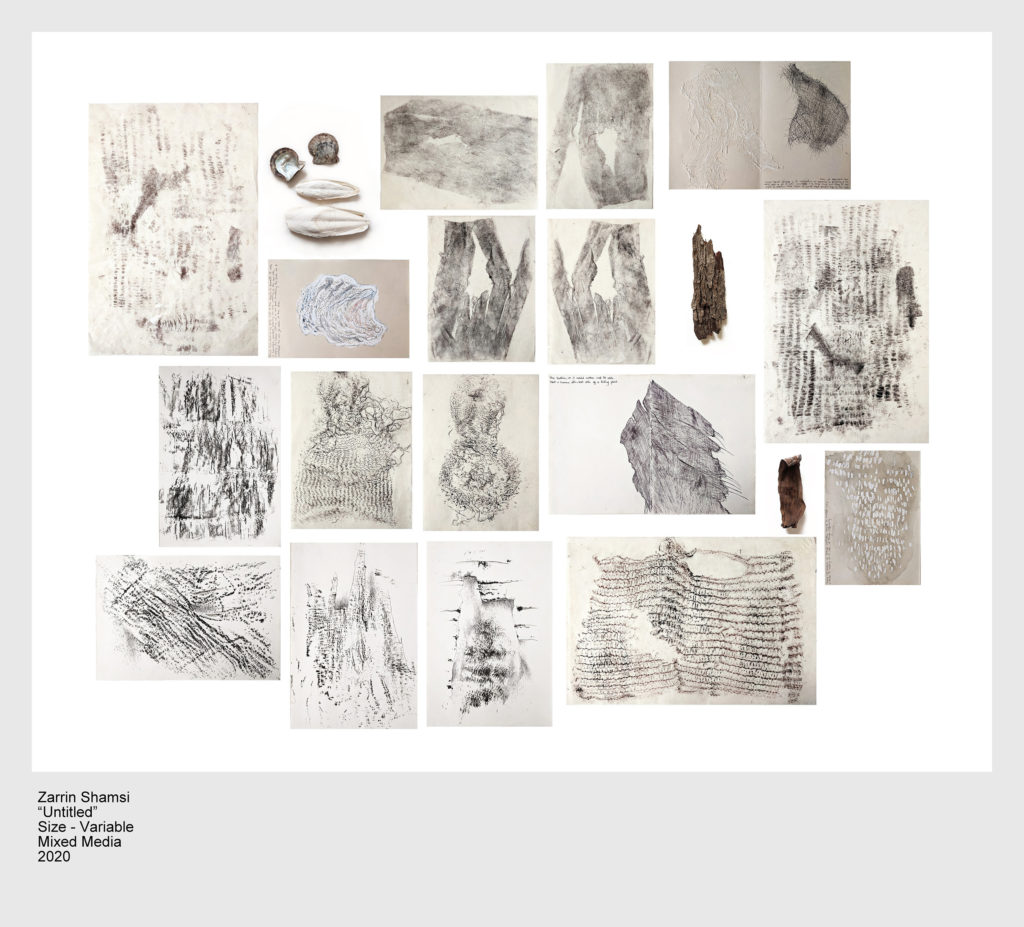
ZM: Your printmaking demonstrates a recurring theme of ‘neglected objects’—objects most people would not offer a second glance—like shells, dried leaves, broken pieces of bark. What is it about these objects that appeals to you and what do you hope to convey through your impressions of their textures?
ZFS: As I mentioned, the third year of college was the most crucial. So, by the end of this year most of us found our interests and got a sense of direction to work on for their final year. For me, the central theme of my work was women. I was focusing on the physical changes and hardships that a woman has to go through during her lifetime. And I was experimenting with different materials at that time. I was juxtaposing different objects and materials on my paintings; for example, fish bones, safety pins, gauze, etc. Slowly and gradually, I started looking at different objects around me (mostly natural objects), which I was able to relate to femininity in terms of their visual and symbolic quality. So, there was a very gradual shift in my work as I engaged more in my art practice. And that’s where my collection of objects came to be a part of my art practice.
ZM: I perceived that I was able to communicate through objects that are found in nature. The objects represent my words, words that remain unspoken and unexpressed.
ZFS: I form attachments to small things and objects I find around me. It gives me pleasure to collect objects from the ground, which are almost neglected or thrown away (either by humans or by nature) without being given much attention. I have collected a variety of objects over a period of time, drew them, painted them and studied them and in this process, I have contrived a close connection to them. They can speak of things which are impossible for me to express in words – acting as a metaphor to the emotions hidden deep within me.
These objects for me are a source of association with people, memory, and the place where it belongs. It reminds me of the experience that I shared around it. Hence, I try to interpret them in my work through drawing them or taking impressions of them, which changes the perspective of how we look at them. It is exciting for me to see how even a “not so important” thing becomes important when it is transferred on to a paper with some thoughtful input. A goal within my work is to induce the desire of personal interaction: to be close, to look within, to touch, or to feel the essence of that object.
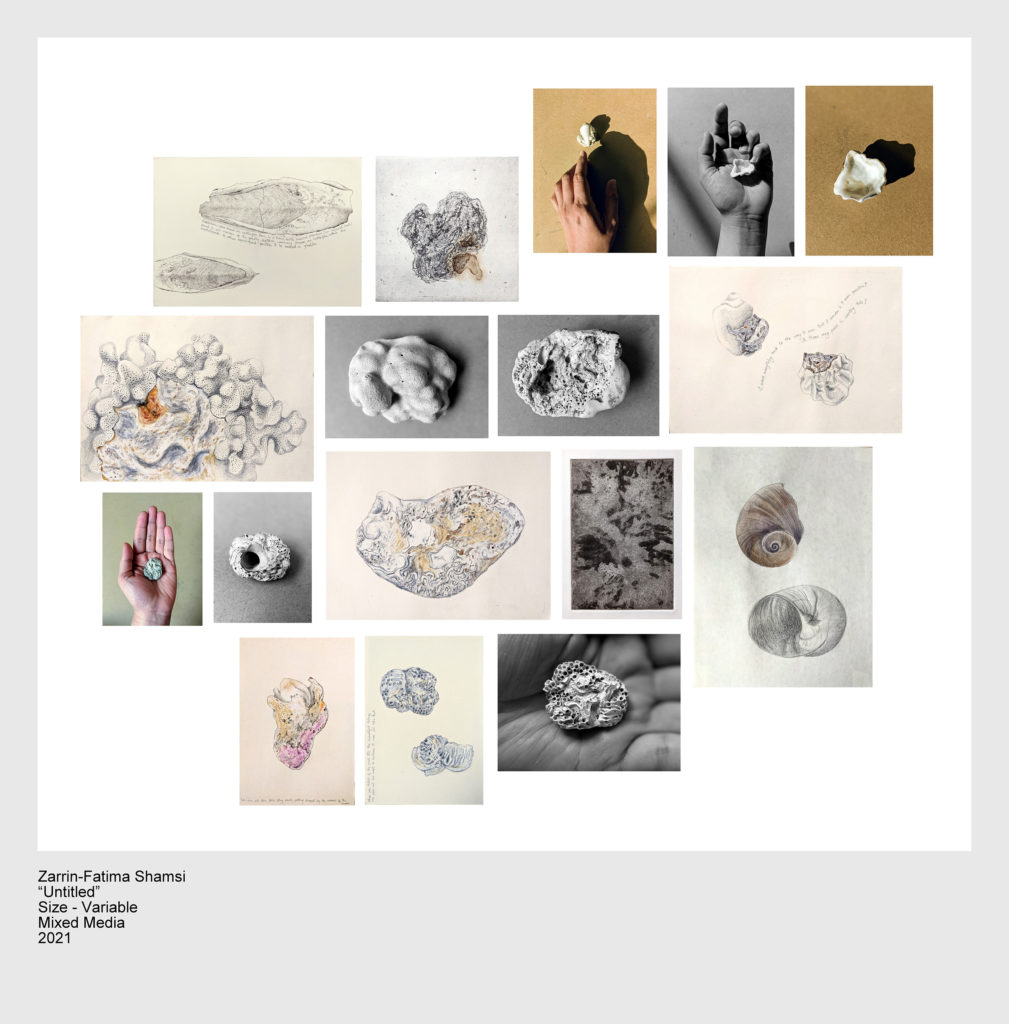
ZM: Some of your artworks on Instagram are accompanied by free verse. Do you also write a lot of poetry?
ZFS: No, not really. I do write some of the things, but I'm not into poetry or writing. I maintain a journal where I like to write down my feelings and whatever I have in mind from time to time, but I'm not really a writer or a poet in that sense. The text that you see along with my work, are usually taken from somewhere if I find something interesting or something that can express my presentation. Since my work is very abstract, the text adds to the work. It gives a sense of direction for the viewers also, to see in a particular manner, what I was thinking of.
So if I find something that can express my feelings towards those works, I try to incorporate that. Or, you know, some of them are taken from my friend. That's something I do a lot. It's not always me who has written down the text.
ZM: What lessons have you learned in your creative journey that aspiring artists could benefit from?
ZFS: I would say that I'm not an established artist yet. I'm still at a learning stage. I'm very new to this field. So there's a lot to learn. One thing I strongly believe in is that for art, you need a lot of patience.
You have to be patient and you have to continue doing your work. You have to be true to your work. And once you’re doing work constantly, you can sustain yourself as an artist and things will fall into place. You have to find yourself. That's the most important part. Things will work out if you're true to yourself.
You have to figure out what you're interested in doing. What makes you do the art that you're doing. How you can represent your work in a different manner which no artist has done. Every artist has a speciality of their own. You can see an artist's work and you can say that this person has done that because everyone has a different quality to do their work. That's what is important to figure out as an artist. It takes time, but we have to keep doing it.
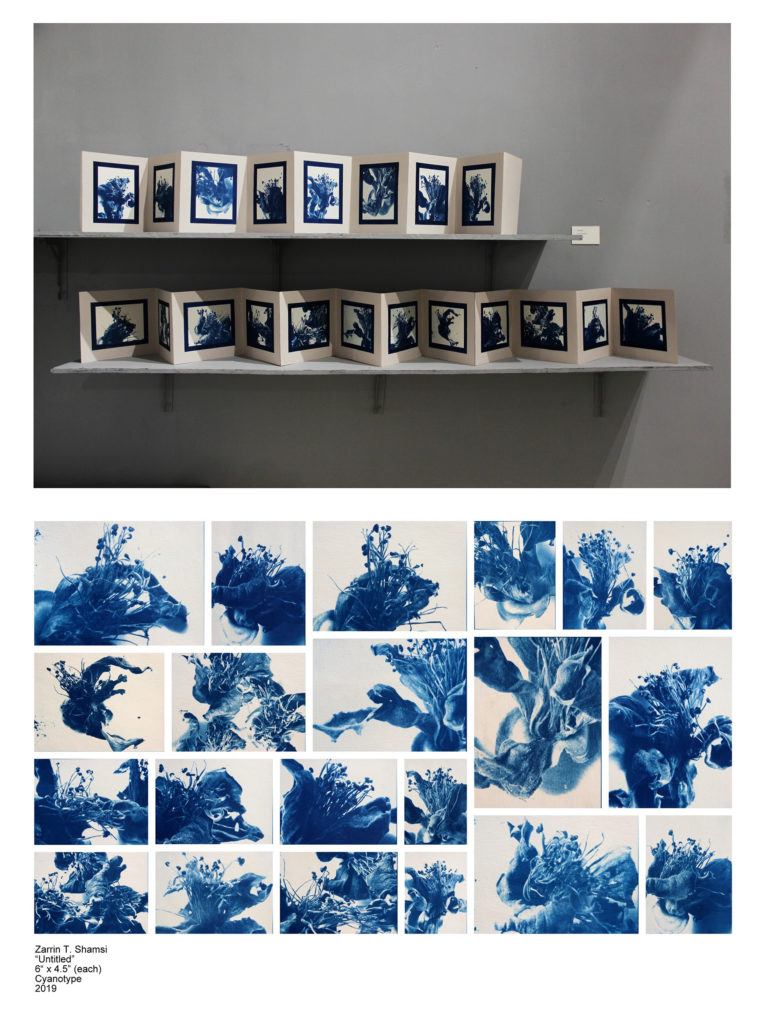
ZM: How has 2020, a year of unprecedented change, affected you and your art?
ZFS: I don't think 2020 has affected my art, but it has affected the way I showcase it. I never used to upload my works on any social media platform. But, since the beginning of this year, I started uploading them on Instagram. After that, the lockdown happened and it was the only platform where you could showcase your work, meet new people, connect with people who were in the art fields. So that's where it all began for me because I never used to do that.
ZM: You’ve participated in several virtual exhibitions over the last few months. How do you feel about the shifting landscape in the post-COVID19 era through which art is being showcased and viewed, as opposed to interacting with it in a physical space?
ZFS: There are both pros and cons to having a virtual exhibition. It's a very important platform to have a virtual exhibition especially during the COVID situation. There was no other way. So it was an important part. And I think that the advantage was that anyone from anywhere in the world could access this exhibition. There were a lot of possibilities to also work with virtual exhibitions, but I don't think that it can completely replace the idea of a physical show, because there are some works which need that physical attention. They're meant to be seen personally. So you can not completely [abandon] that, but for now it's a good option to have virtual exhibitions. It's good exposure for artists.

